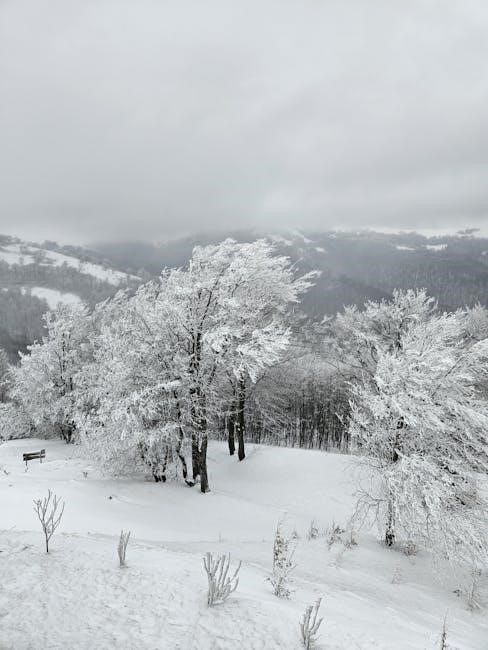Ernest Hemingway’s Hills Like White Elephants is a landmark short story, widely studied in its PDF format for its concise prose and deep symbolism.
1.1 Overview of the Story
Hills Like White Elephants by Ernest Hemingway is a concise, dialogue-driven story set in a Spanish train station. It revolves around an American man and a woman discussing a life-altering decision, hinted to be an abortion. The narrative is sparse, with subtle tension and underlying emotional complexity. The girl’s comparison of distant hills to white elephants sparks a deeply symbolic conversation, reflecting themes of choice, ambiguity, and unresolved conflict. Available in PDF format, the story remains a seminal work in modern literature.
1.2 Importance of the PDF Format
The PDF format of Hills Like White Elephants is widely accessible, offering a clean, readable version of Hemingway’s concise prose. It preserves the original text’s integrity, making it ideal for academic study and easy to share. The PDF is available from sources like the University of Virginia and online archives, providing readers with a reliable way to engage with this iconic story. Its digital format ensures timeless accessibility for scholars and literature enthusiasts alike.

Plot Summary
The story revolves around an American man and a woman at a Spanish train station, engaging in a tense conversation about a life-changing decision, symbolized by the surrounding landscape.
2.1 Setting: The Train Station in Spain
The story unfolds at a sparse train station in Spain, situated between two rail lines in the Ebro valley. The station lacks shade and trees, emphasizing its desolate atmosphere. Across the valley, long, white hills contrast with the dry, barren landscape. The setting symbolizes transition and isolation, mirroring the characters’ emotional state. The warm shadow of the station building offers minimal relief, highlighting the stark environment that underscores the tension in their conversation.
2.2 The Two Main Characters
The story centers on an unnamed American man and a woman, often referred to simply as “the girl,” at a Spanish train station. Their conversation is tense and subtle, hinting at deeper emotional struggles. The man appears detached and controlling, while the woman is reflective and uncertain. Their dialogue reveals underlying conflicts about their relationship and future, with the man pressing for a decision that aligns with his desires. The characters’ unnamed status emphasizes their universality and the story’s focus on their interaction. The woman’s emotional vulnerability contrasts with the man’s pragmatic demeanor, creating a dynamic that drives the narrative’s tension.
2.3 The Dialogue-Driven Narrative
The story is renowned for its minimalist, dialogue-driven approach, where the characters’ sparse conversation carries profound emotional weight. Hemingway’s use of subtlety allows readers to infer underlying tensions and unspoken emotions. The PDF version of the story highlights the simplicity of the narrative structure, emphasizing the raw, unadorned language that has become a hallmark of Hemingway’s style. This approach creates a sense of immediacy, drawing readers into the characters’ intimate yet strained interaction.

Themes in “Hills Like White Elephants”
The story explores themes of abortion, tension, and symbolism through its sparse dialogue. The PDF version emphasizes the emotional depth and complexity of the characters’ decisions.
3.1 The Theme of Abortion
The story subtly explores the theme of abortion through the tense dialogue between the American man and the girl. The PDF version highlights the emotional weight of their decision, emphasizing the silent struggle between personal desires and societal expectations. Hemingway’s concise prose leaves much unsaid, mirroring the complexity of their situation and the moral ambiguity surrounding abortion, making it a powerful yet understated central theme in the narrative.
3.2 The Tension Between the Characters
The conversation between the American man and the girl is fraught with unspoken tension, evident in their dialogue’s subtlety. The PDF highlights their emotional struggle, as the man appears detached, urging a decision, while the girl seeks reassurance. Their exchange reveals underlying power dynamics and unspoken fears, creating a palpable sense of conflict beneath the surface of their seemingly casual discussion about the future.
3.3 The Symbolism of the Hills and the Valley
The white hills across the Ebro valley symbolize purity and clarity, while the dry, brown landscape reflects the characters’ emotional barrenness. The girl’s remark that the hills “look like white elephants” suggests something rare and significant, mirroring the gravity of their decision. The contrasting imagery underscores the tension between their external surroundings and the internal conflict, highlighting the story’s central themes of choice and ambiguity.

Character Analysis
The story revolves around the American man and the girl, whose tense dialogue reveals their contrasting personalities and the underlying conflict shaping their relationship.
4.1 The American Man: His Role and Motivations
The American man is portrayed as detached and controlling, pushing the girl toward a decision that aligns with his desires; His dialogue reflects a rational, almost clinical approach, emphasizing convenience and simplicity. Through subtle yet firm language, he exerts influence, revealing his primary motivation: maintaining a carefree lifestyle without the responsibilities of parenthood. His character embodies Hemingway’s exploration of masculine detachment and emotional restraint.
4.2 The Girl: Her Perspectives and Emotions
The girl’s emotions are deeply conflicted, reflecting her desire to preserve a meaningful connection while facing an uncertain future. Her comparison of the hills to white elephants symbolizes her perspective on pregnancy as something rare and significant. Though she seeks reassurance, her hesitation reveals a longing to hold onto something precious, contrasting sharply with the man’s detachment. Her dialogue conveys vulnerability and an unspoken plea for understanding, highlighting her emotional depth and internal struggle.
4.3 The Relationship Between the Two Characters
The relationship between the American man and the girl is strained, marked by subtle tension and unspoken emotions. Their dialogue reveals a power imbalance, with the man pushing for a decision while the girl expresses hesitation. The setting of the train station symbolizes a crossroads, mirroring their emotional standoff. Their interaction suggests a deep-seated conflict, with the man’s detachment contrasting the girl’s vulnerability, highlighting the complexity of their connection and the weight of their unspoken thoughts.

Symbolism in the Story
The white hills symbolize distant desires, while the valley represents a daunting decision. The train station embodies a transitional moment, reflecting the characters’ uncertain future and internal conflict.
5.1 The White Hills as a Symbol
The white hills in Hemingway’s story are a potent symbol, representing distant desires and unattainable goals. Their mention by the girl sparks a deeper conversation about choices and uncertainty. The hills, described as “long and white,” stand juxtaposed against the barren landscape, mirroring the emotional distance between the characters. This imagery underscores themes of longing and the elusiveness of decisions, central to the narrative’s tension and subtext.
5.2 The Valley and Its Significance
The valley in Hills Like White Elephants serves as a symbolic backdrop, representing a void or emotional distance between the characters. Situated near the Ebro river, it is described as dry and barren, contrasting with the distant white hills. This stark landscape mirrors the couple’s internal conflict, emphasizing their emotional detachment and the uncertainty of their decisions. The valley’s desolation underscores the story’s themes of isolation and unresolved tension.
5.3 The Train Station as a Symbol of Transition
The train station in Hills Like White Elephants symbolizes a pivotal moment of transition for the couple. It represents a physical and emotional crossroads, where decisions must be made. The station’s location between two rail lines mirrors the characters’ indecision, highlighting the tension between moving forward or staying behind. This setting underscores the story’s themes of uncertainty and the transformative power of choice, central to Hemingway’s narrative.

Literary Analysis
Hills Like White Elephants showcases Hemingway’s Iceberg Theory, where most of the story’s meaning lies beneath the surface. The sparse dialogue and subtle subtext reveal deep emotional currents, while the ambiguous ending reflects Hemingway’s minimalist style, leaving readers to interpret the characters’ fates and motivations.
6.1 Hemingway’s Iceberg Theory
Hemingway’s Iceberg Theory is exemplified in Hills Like White Elephants, where most of the story’s meaning lies beneath the surface. The sparse dialogue and subtle subtext reflect this style, leaving readers to infer deeper emotions and conflicts. The PDF format highlights the story’s structure, showcasing how Hemingway’s minimalist approach creates a powerful narrative through omission. This technique emphasizes the unsaid, making the story’s themes and tensions profoundly implicit.
6.2 The Use of Subtext
The story relies heavily on subtext, with the characters’ dialogue hinting at deeper emotional and psychological layers. Hemingway’s concise prose leaves much unsaid, allowing readers to interpret the tension and unspoken conflicts. The PDF version underscores this subtlety, as the sparse text encourages close reading. Subtext is crucial in conveying the characters’ true feelings, particularly their differing perspectives on the central conflict, making the narrative both ambiguous and profound.
6.3 The Ambiguity of the Ending
The ending of Hills Like White Elephants is deliberately ambiguous, leaving readers to interpret the characters’ ultimate decision. The story concludes without explicit resolution, mirroring the couple’s unresolved tension. Hemingway’s minimalist style amplifies the uncertainty, inviting readers to draw their own conclusions. The PDF version of the story preserves this subtlety, offering no additional commentary and allowing the ambiguity to stand as a testament to Hemingway’s mastery of understatement.

The PDF Version of the Story
The PDF version of Hills Like White Elephants is widely available online, offering easy access to Hemingway’s timeless tale. Sources include academic sites and open anthologies, ensuring its accessibility for readers worldwide.
7.1 Availability and Sources
The PDF version of Hills Like White Elephants is readily available online, accessible through academic platforms, open anthologies, and educational websites. Sources include university repositories, literature archives, and forums discussing Hemingway’s works. The story is often featured in public domain collections, making it easily downloadable for free. Links to the PDF can be found on platforms like Google Scholar and online libraries, ensuring wide accessibility for readers and students worldwide.
7.2 Benefits of Reading the PDF
Reading the PDF version of Hills Like White Elephants offers several advantages. It provides easy access to the story, allowing readers to study Hemingway’s concise prose and subtle dialogue. The PDF format ensures the text remains unchanged, preserving the original structure and intended formatting; Additionally, it enables offline reading, making it ideal for academic analysis or personal study. The clarity and portability of the PDF enhance the overall reading experience, making it a preferred choice for many students and scholars.
7.3 How to Access the PDF
To access the PDF of Hills Like White Elephants, visit academic platforms like Literature in Context or Google Books. Search for “Hills Like White Elephants PDF” on university repositories or open-source libraries. Some versions are available for free, while others may require subscription access. Ensure to use trusted sources to download the authentic text for educational purposes. This format is ideal for close reading and analysis.
Cultural and Historical Context
The story reflects 1920s Spain’s cultural landscape, influenced by Hemingway’s expatriate experiences. The Ebro valley setting underscores the era’s social and political tensions, enriching the narrative’s depth.
8.1 The Setting in 1920s Spain
The story is set in a sparse train station in 1920s Spain, near the Ebro River. The arid landscape, with its long, white hills and dry valleys, reflects the emotional barrenness of the characters. Hemingway’s experiences in Spain during this period influenced the setting, capturing the cultural and social nuances of the time. The isolated station symbolizes a transitional moment, both physically and emotionally, for the characters.
8.2 Hemingway’s Own Experiences
Ernest Hemingway’s personal experiences deeply influenced Hills Like White Elephants. His time in Spain, where he immersed himself in the culture and geography, shaped the story’s setting. Hemingway’s own struggles with relationships and existential themes also resonate in the narrative. His distinctive writing style, known as the “Iceberg Theory,” is evident in the story’s subtlety and emotional depth, reflecting his broader life experiences and artistic philosophy.
8.3 The Influence of the Story on Later Literature
Hills Like White Elephants has profoundly influenced modern literature, inspiring authors to adopt Hemingway’s minimalist style and subtle dialogue. Its focus on subtext and emotional undertones has become a benchmark for contemporary writers. The story’s exploration of existential themes and symbolic imagery has also encouraged experimentation in narrative structure, making it a foundational text for later literary movements and techniques.

Comparisons with Other Hemingway Works
Hills Like White Elephants shares themes of existentialism and minimalist prose with Hemingway’s other works, like The Old Man and the Sea, yet its dialogue-driven style stands unique.
9.1 Similar Themes in “The Old Man and the Sea”
Hills Like White Elephants and The Old Man and the Sea share themes of existential struggle and human perseverance. Both stories explore internal conflict, with Hemingway’s minimalist prose amplifying emotional depth. Santiago’s lonely journey mirrors the tense dialogue in Hills Like White Elephants, reflecting Hemingway’s focus on human resilience and the search for meaning in challenging circumstances.
9.2 The Unique Style of “Hills Like White Elephants”
Ernest Hemingway’s Hills Like White Elephants showcases his signature minimalist prose, relying on subtle dialogue and subtext. The story’s Iceberg Theory leaves much unsaid, allowing readers to infer deeper meanings. Its sparse, direct language contrasts with the emotional complexity of the characters’ conversation. This style creates a powerful, understated narrative that resonates deeply, making it a hallmark of Hemingway’s unique literary approach.
9.3 The Story’s Place in Hemingway’s Oeuvre
Hills Like White Elephants stands as a pivotal work in Hemingway’s oeuvre, exemplifying his ability to convey profound emotional depth through minimalism. This story, alongside others like The Old Man and the Sea, solidified his reputation for sparse, impactful prose. Its exploration of human tension and moral dilemmas aligns with themes found in his other works, making it a cornerstone of his literary legacy.

Educational Resources
Study guides, essays, and classroom materials for Hills Like White Elephants are widely available in PDF format, aiding educators and students in analyzing Hemingway’s work.
10;1 Study Guides and Essays
Study guides and essays on Hills Like White Elephants are readily available in PDF format, offering in-depth analysis of themes, symbolism, and character dynamics. These resources, often sourced from universities and educational platforms, provide students with a deeper understanding of Hemingway’s concise prose and the story’s underlying tensions. They are invaluable for both independent study and classroom discussions, aiding in the interpretation of the narrative’s subtleties.
10.2 Teaching the Story in Classrooms
Teaching Hills Like White Elephants in classrooms is enhanced by its availability in PDF format, making it easily accessible for students. Educators often use the story to teach Hemingway’s Iceberg Theory and subtext, encouraging close reading and discussion. Classroom activities focus on analyzing dialogue, symbolism, and character motivations, fostering deeper understanding of the narrative’s complexity and thematic depth, while promoting critical thinking and literary analysis skills among students.
10.3 Online Discussions and Forums
Online discussions and forums provide vibrant platforms for analyzing Hills Like White Elephants. The availability of the story in PDF format has fueled debates on websites like rae.ru and academic forums, where readers explore themes, symbolism, and character dynamics. These spaces allow for global interactions, fostering deeper insights and diverse interpretations of Hemingway’s work, making it a valuable resource for both students and literature enthusiasts worldwide.

Adaptations and References
The story’s themes are often referenced in popular culture, with its PDF availability making it a staple in academic discussions and inspiring various literary adaptations and interpretations.
11.1 Film and Stage Adaptations
The story’s concise dialogue and rich subtext have inspired various film and stage adaptations. Its themes of tension and symbolism translate well into visual media, with directors interpreting the emotional depth through cinematic techniques. While no major blockbuster adaptations exist, numerous indie films and theatrical productions have reimagined the story, capturing its essence for modern audiences. The PDF version remains a key resource for these creative interpretations, ensuring Hemingway’s work continues to inspire new adaptations.
11.2 References in Popular Culture
The story’s themes and imagery, such as the white elephants, are frequently referenced in popular culture, including music and literature, often symbolizing hidden meanings or emotional tension. The availability of the PDF version has made it easier for creators to draw inspiration from Hemingway’s work, ensuring its continued influence in various forms of media.
11.3 The Story’s Impact on Modern Media
Hills Like White Elephants has significantly influenced modern media, with its themes of subtle tension and symbolism appearing in films, TV shows, and music. Its dialogue-driven style has inspired screenwriters, while its minimalist approach has shaped narrative techniques. The story’s exploration of unresolved conflict continues to resonate, making it a timeless reference in contemporary storytelling, further amplified by its accessibility in PDF format.
Hills Like White Elephants remains a timeless tale, its themes of choice and ambiguity resonating deeply. The PDF format ensures its accessibility, preserving Hemingway’s legacy for future readers.
12.1 The Enduring Relevance of the Story
Hills Like White Elephants continues to captivate readers with its universal themes of decision-making and human complexity. The story’s ambiguity mirrors real-life dilemmas, making it endlessly relatable. Its concise, dialogue-driven style, as seen in the PDF versions available online, showcases Hemingway’s mastery of subtlety. This timeless appeal ensures the story remains a cornerstone of literary study and personal reflection.
12.2 The Importance of the PDF Format
The PDF format of Hills Like White Elephants ensures easy accessibility and readability. It preserves Hemingway’s original formatting, crucial for understanding the story’s subtle dialogue and pacing. The PDF version is widely available online, making it convenient for students and researchers to access and analyze. Its portability and clarity enhance the reading experience, allowing deeper engagement with the story’s themes and symbolism.